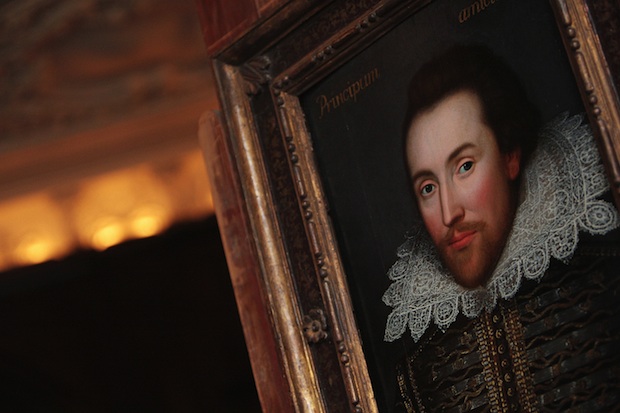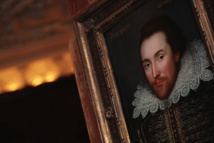From silks woven with gold thread to baroque satin embellished with semi-precious stones, it would be understandable if subsidy-starved theatre companies tried to cut back on the cost of Shakespearean costumes.
That they do not is largely down to the vanity of Elizabethans and their obsession with fancy outfits, according to award-winning British costume designer Jenny Tiramani, three of whose costumes feature in the exhibition.
One high-necked ruff collar she made for a 2012 production of "Richard III" at London's Globe theatre cost more than $2,000 alone.
"It was the best we could do, but that price is nothing compared to the ruffs that were worn at the Elizabethan court which in our money would cost 10, 20 or even 100 times that amount," she told AFP.
The most extreme ruffs were over a foot or more wide and needed a wire frame to hold the frills in position around the neck.
"They were so elaborate it could take days for a highly-paid laundress to reset your ruff -- to wash it, starch it, carefully pin it out on a pillow to get the lace back into shape and then press it, rub it and polish it," Tiramani said.
- Gemstones and silk -
Other extreme shapes fashionable in the late 16th century included the wheel farthingale, a hoop-like structure around the waist that supported a voluminous skirt.
For men, the peasecod doublet was a tight-fitting jacket that was padded to create a bulge over the stomach.
The exhibition, which has just opened at the National Centre for Stage Costumes in the central French town of Moulins, brings together scores of costumes from over a century of theatrical productions.
Among the most spectacular is a gold-coloured Elizabethan gown designed by French fashion designer Thierry Mugler for a 1985 production of "Macbeth" at the Avignon Festival.
One of three Lady Macbeth costumes in the exhibition, Mugler's signature exaggerated proportions and sculptural style are given full rein in its huge box-like skirt and sleeves shaped like wings.
According to historians, the Elizabethans' love of luxury was partly due to an expanding merchant class which used clothes to signal their new wealth and status.
- Preening Elizabethans -
Their sartorial excess eventually became such a challenge to the existing social order that Queen Elizabeth I stepped in to try and curb it.
Concerned that it was no longer possible to identify the nobility by their clothing alone, parliament took action by updating the country's sumptuary laws.
Under the laws, individual expenditure on clothing was limited and restrictions placed on the colours and fabrics a person could wear in line with their social class.
Purple silk was strictly for royalty while dukes and earls could use it only on certain items such as a doublet, a buttoned jacket, or hose, later called stockings.
Even the length of the points on men's shoes was regulated to show who was noble and who wasn't -- two-and-a-half times the length of the foot for a duke, half the length for a common man.
But Tiramani, who earlier this month won the 2014 Tony award for her costumes for the Globe's "Twelfth Night", said the laws had limited effect.
"There are cases recorded of people flouting the laws and being punished for it but I wouldn't say they were extremely effective. Certainly it was many years since the last person had been executed, for example, for wearing purple!" she said.
"People wanted to show as much fabric as they possibly could to signal wealth, it was a society absolutely obsessed with status," she added.
The show runs until early January at the museum, about a three-hour train ride from Paris. Opened in 2006 in a restored 18th-century cavalry, the Centre bills itself as the world's only venue dedicated to the heritage of live entertainment, with more than 8,000 costumes and accessories, including a permanent exhibition dedicated to the late ballet icon Rudolf Nureyev of items donated by the Nureyev Foundation.
---------------------------------------------------------------------------
That they do not is largely down to the vanity of Elizabethans and their obsession with fancy outfits, according to award-winning British costume designer Jenny Tiramani, three of whose costumes feature in the exhibition.
One high-necked ruff collar she made for a 2012 production of "Richard III" at London's Globe theatre cost more than $2,000 alone.
"It was the best we could do, but that price is nothing compared to the ruffs that were worn at the Elizabethan court which in our money would cost 10, 20 or even 100 times that amount," she told AFP.
The most extreme ruffs were over a foot or more wide and needed a wire frame to hold the frills in position around the neck.
"They were so elaborate it could take days for a highly-paid laundress to reset your ruff -- to wash it, starch it, carefully pin it out on a pillow to get the lace back into shape and then press it, rub it and polish it," Tiramani said.
- Gemstones and silk -
Other extreme shapes fashionable in the late 16th century included the wheel farthingale, a hoop-like structure around the waist that supported a voluminous skirt.
For men, the peasecod doublet was a tight-fitting jacket that was padded to create a bulge over the stomach.
The exhibition, which has just opened at the National Centre for Stage Costumes in the central French town of Moulins, brings together scores of costumes from over a century of theatrical productions.
Among the most spectacular is a gold-coloured Elizabethan gown designed by French fashion designer Thierry Mugler for a 1985 production of "Macbeth" at the Avignon Festival.
One of three Lady Macbeth costumes in the exhibition, Mugler's signature exaggerated proportions and sculptural style are given full rein in its huge box-like skirt and sleeves shaped like wings.
According to historians, the Elizabethans' love of luxury was partly due to an expanding merchant class which used clothes to signal their new wealth and status.
- Preening Elizabethans -
Their sartorial excess eventually became such a challenge to the existing social order that Queen Elizabeth I stepped in to try and curb it.
Concerned that it was no longer possible to identify the nobility by their clothing alone, parliament took action by updating the country's sumptuary laws.
Under the laws, individual expenditure on clothing was limited and restrictions placed on the colours and fabrics a person could wear in line with their social class.
Purple silk was strictly for royalty while dukes and earls could use it only on certain items such as a doublet, a buttoned jacket, or hose, later called stockings.
Even the length of the points on men's shoes was regulated to show who was noble and who wasn't -- two-and-a-half times the length of the foot for a duke, half the length for a common man.
But Tiramani, who earlier this month won the 2014 Tony award for her costumes for the Globe's "Twelfth Night", said the laws had limited effect.
"There are cases recorded of people flouting the laws and being punished for it but I wouldn't say they were extremely effective. Certainly it was many years since the last person had been executed, for example, for wearing purple!" she said.
"People wanted to show as much fabric as they possibly could to signal wealth, it was a society absolutely obsessed with status," she added.
The show runs until early January at the museum, about a three-hour train ride from Paris. Opened in 2006 in a restored 18th-century cavalry, the Centre bills itself as the world's only venue dedicated to the heritage of live entertainment, with more than 8,000 costumes and accessories, including a permanent exhibition dedicated to the late ballet icon Rudolf Nureyev of items donated by the Nureyev Foundation.
---------------------------------------------------------------------------









 Home
Home Politics
Politics











